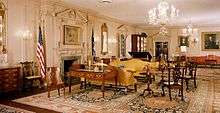Clement Conger
Clement Ellis Conger (October 15, 1912 – January 11, 2004) was an American museum curator and public servant. He served as director of the U.S. Department of State Office of Fine Arts, where in that role he worked as curator of both the Diplomatic Reception Rooms and Blair House. He also served as Curator of the White House, at the pleasure of Presidents Nixon, Ford, Carter, and Reagan.[1][2] Prior to working as a curator, Conger served as a Foreign Service Officer, as the Deputy Chief of Protocol of the United States and as the Assistant Secretary of the Combined Chiefs of Staff.
Clement Conger | |
|---|---|
.jpg) Clement Ellis “Clem” Conger | |
| 4th White House Curator | |
| In office 1970–1986 | |
| President | Richard Nixon Gerald Ford Jimmy Carter Ronald Reagan |
| Preceded by | James R. Ketchum |
| Succeeded by | Rex Scouten |
| 1st Curator of the Diplomatic Reception Rooms | |
| In office 1961–1992 | |
| Deputy | Gail F. Serfaty |
| Preceded by | Position established |
| Succeeded by | Gail F. Serfaty |
| Deputy Chief of Protocol of the United States | |
| In office 1958–1961 | |
| Assistant Chief of Protocol of the United States | |
| In office 1955–1957 | |
| Special Assistant, Arms Control and Disarmament Agency | |
| Assistant Secretary of the Combined Chiefs of Staff | |
| In office c.1943 – c.1945 | |
| Personal details | |
| Born | Clement Ellis Conger October 15, 1912 Harrisonburg, Virginia |
| Died | January 11, 2004 (aged 91) Delray Beach, Florida |
| Cause of death | Pneumonia |
| Resting place | Glendale, California |
| Spouse(s) | Lianne Hopkins Conger |
| Children |
|
| Education | Strayer College George Washington University |
| Occupation | Cultural heritage management |
| Known for | Creation of the Diplomatic Reception Rooms |
| Committees | Fine Arts Committee |
| Military service | |
| Allegiance | United States of America |
| Branch/service | |
| Years of service | c.1940–1945 |
| Rank | |
| Commands | Assistant Secretary of the Combined Chiefs of Staff |
Life

He graduated from Strayer College. He worked as an office manager for the Chicago Tribune, and for U.S. Rubber Co. He was assistant secretary for the Combined Chiefs of Staff, during World War II. He worked for the State Department, and became deputy chief of protocol, from 1958 to 1961.
Works
- Clement E. Conger, Mary K. Itsell, Treasures of State: Fine and Decorative Art in the Diplomatic Reception Rooms of the U.S. Department of State, H.N. Abrams, 1991, ISBN 978-0-8109-3911-0
References
- Files, John (January 13, 2004). "Clement Conger, 91, Curator Who Beautified Federal Halls". The New York Times.
- Kempster, Norman (August 7, 1990). "Insider : He Took Charge of a Shabby State Department : Clement Conger is his name and furnishing is his game. For the last 30 years, he has made sure that foreign VIP's like what they see in Washington D.C". Los Angeles Times.
External links
- Reminiscences of Clement Conger : oral history, 1972., Columbia University
- Constance M. Greiff (1987). Independence: the creation of a national park. University of Pennsylvania Press. ISBN 978-0-8122-8047-0.
- http://leg1.state.va.us/cgi-bin/legp504.exe?041+ful+SJ187+pdf
- https://web.archive.org/web/20111012205352/http://thenewnixon.org/2009/10/05/pat-nixon-and-the-golden-age-of-the-white-house/
- https://web.archive.org/web/20110826141712/http://sackheritage.com/articles/articles.php?articleID=13